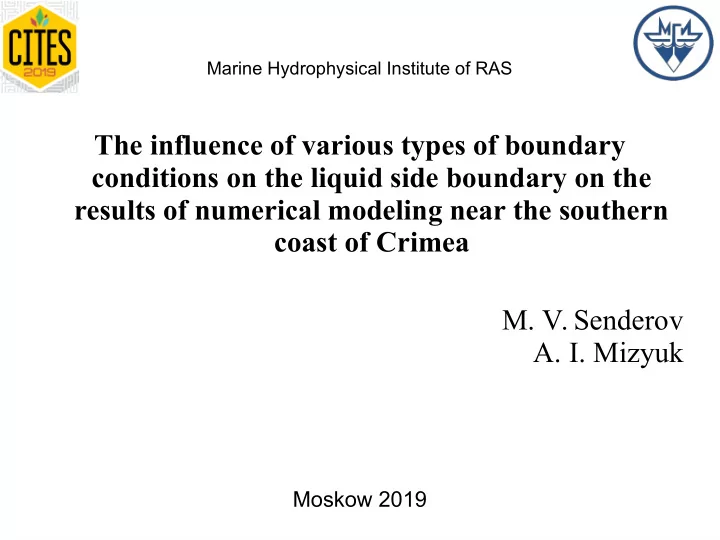

Marine Hydrophysical Institute of RAS The influence of various types of boundary conditions on the liquid side boundary on the results of numerical modeling near the southern coast of Crimea M. V. Senderov A. I. Mizyuk Moskow 2019
Introduction Obtaining a short-term forecast of the entire basin with a resolution that allows reproducing meso-and sub- mesoscale processes for reasonable machine time requires significant computational power. One of the ways to obtain such data is to create a regional configuration (nested domain). In this work, we created such a domain for the southern coast of Crimea. In order to correctly reproduce all the processes within the region under study, it is necessary to take into account external influence. This is achieved by setting boundary conditions at the open liquid boundaries. 2
Purpose Reproduction of mesoscale and submesoscale processes in a selected region of the Black Sea. Investigate the influence of various types of boundary conditions on the liquid side boundary on the results of numerical simulation. 3
Objective Creating a regional configuration; Numerical modeling with different boundary conditions on the open side boundary; Compare of the results of numerical simulation in the experiments conducted among themselves and with the results obtained in the basin configuration. 4
NEMO model configuration 5
Boundary conditions for regional and basin configurations To parameterize horizontal turbulent exchange in a regional configuration, a biharmonic operator with coefficients (–5×10 8 m 4 /s) and (–5×10 7 m 4 /s) for viscosity and for diffusion, respectively, is used. In the basin configuration, the values of these coefficients are (–5×10 9 m 4 /s) and (-4×10 8 m 4 /s). 6
Boundary conditions for regional and basin configurations The boundary conditions on the surface in the conducted numerical experiments for the two configurations were set based on the results of the atmospheric reanalysis ERA5; On solid lateral boundaries for the velocity components, a sticking condition is imposed for both configurations. Used "quadratic" friction at the bottom. For the equations of advection — diffusion of heat and salt on solid lateral boundaries and the bottom — conditions are set for the absence of flows. 7
Boundary conditions for regional configurations At the open lateral boundary, in the regional configuration, the values for temperature, salinity, level, and flow rates were set. These data were taken from the results of numerical modeling of the basin configuration.. 8
Schemes for setting boundary conditions at open side boundaries 1) Flow Relaxation Scheme (FRS); 2) Flather radiation scheme; 3) Dirichle type boundary conditions. 9
Flow Relaxation Scheme (FRS) 1) Flow Relaxation Scheme: applies a simple relaxation of the model fields to externally-specified values over a zone next to the edge of the model domain. Given a model prognostic variable Φ: where Φ e — is the specified external field; Φ m — is the model solution; d — gives the discrete distance from the model boundary and α is a parameter that varies from 1 at d = 1 to a small value at d=N. The function α( d ) is specified as a tanh function: Thus the model solution is completely prescribed by the external conditions at the edge of the model domain and is relaxed towards the external conditions over the rest of the FRS zone. The application of a relaxation zone helps to prevent spurious reflection of outgoing signals from the model boundary. This is typically set to a value between 8 and 10. 10
Flather radiation scheme and Dirichle type boundary conditions 2) Flather radiation scheme: The scheme is a radiation condition on the normal, depth-mean transport across the open boundary. It takes the form: where U – is the depth-mean velocity normal to the boundary and η – is the sea surface height, both from the model. The subscript e indicates the same fields from external sources. The speed of external gravity waves is given by , h –and h is the depth of the water column. The depth-mean normal velocity along the edge of the model domain is set equal to the external depth-mean normal velocity, plus a correction term that allows gravity waves generated internally to exit the model boundary. 3) When using Dirichlet-type boundary conditions, the values at the boundary of the region are equal to the values from the external (basin) configuration. 11
Experiments Schemes for setting boundary conditions at open side boundaries for: Sea surface Temperature and Baroclinic velosity Barotropic velocities salinity Flather radiation Experiment 1 FRS FRS Not counted scheme Dirichle Dirichle Experiment 2 Not counted Not counted Experiment 3 Not counted FRS FRS Not counted Flather radiation Dirichle Experiment 4 FRS Not counted scheme Flather radiation Dirichle Flather radiation Experiment 5 Not counted scheme scheme Flather radiation Flather radiation Experiment 6 FRS Not counted scheme scheme 12
Rezults 13
Rezults 14
Rezults 15
Rezults 16
Rezults 17
Rezults 18
Rezults 19
Conclusions When using the FRS in the fields of temperature and salinity, at the open boundary, there is no numerical noise. Using the FRS helps to prevent spurious reflection of outgoing signals from the model boundary. Sea level is reproduced correctly when using the Flather scheme. This work was fulfilled in Marine Hydrophysical Institute Russian Academy of Sciences with the support assignment № 0555-2019-0002 "Interdisciplinary Numerical Modeling and High Performance Computing" 20
Thank you for attention! Questions. 21
Recommend
More recommend